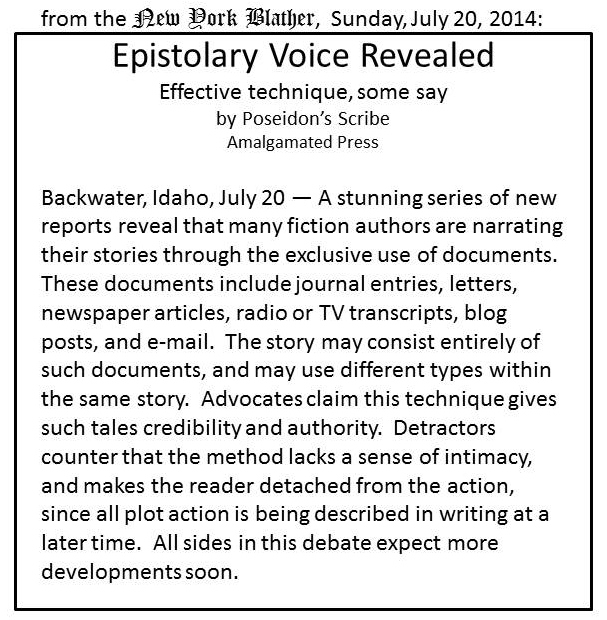As you plan your fiction stories, one important consideration is figuring out how they will be told. In other words, who is the narrator? You have several choices, each with benefits and drawbacks.
 I’ve discussed Point of View (POV) before, but this is slightly different. Today I’m talking about Narrative Voice. Wikipedia’s article on Narrative Mode discusses POV and Narrative Voice as separate items.
I’ve discussed Point of View (POV) before, but this is slightly different. Today I’m talking about Narrative Voice. Wikipedia’s article on Narrative Mode discusses POV and Narrative Voice as separate items.
You might invent your own new type of Narrative Voice, but for now, the main categories are Stream-of-Consciousness, Character Voice, Epistolary, and various Third Person voices.
- Stream of Consciousness. You’re in my mind as I tell this, getting every little thought. Some connected, some not (doesn’t matter), even partial. What I’m conveying is the scattered, haphazard/fleeting nature of a human mind’s thoughts as they carom-collide-cascade around inside a skull. The advantage (good news!) is getting that intense/inside/intimate sense of one person’s—a character, or outside narrator (you choose)—perspective on the story’s events. A downside-disadvantage-drawback-(damn!) is that it can be hard to write, hard to read, hard, hard, hard to pull off well.
- Character Voice. Yeah, I’m a character, but the author’s makin’ me do double duty by also tellin’ the story. You readers’ll see things through my eyes, and I’ll let you know exactly what I think about everyone else. I’m a main character, but the author coulda picked one of them spear carriers. My author also picked first person, but he mighta picked third person instead. By the way, you can trust me. But some o’ these other character voice narrators in other stories? They lie. They’re what you call ‘unreliable voice narrators’ and you gotta sort out the truth yourself. Another type you might come across is the ‘naive narrator.’ Sometimes ya get these kids tellin’ the story, or worse is, some adult whose cheese ain’t sittin’ square on top of his cracker, if you know what I mean. With Character Voice, you’re gonna feel like you’re right with me, part of the action. Still, even I can’t really be everywhere and see everything, so pick your narrator character carefully.
- Third-Person Subjective. Jane knew her author was using her to tell his story, and she secretly resented it. All the story’s actions got to the reader through her eyes and other senses. Worse, the author was just telling the reader many of her innermost thoughts. In her story’s case, the author used Third Person Subjective – Limited in that he never strayed from Jane’s mind. She wished he had chosen Third Person Subjective – Omniscient instead, and told the story by switching into other characters’ minds every so often. It certainly didn’t help matters that this was known as the most popular and currently most common type of narration.
- Third Person Objective. James saw what his author was doing. He was narrating the story by describing what James sensed, but only what James sensed. No feelings or thoughts were involved at all. James drove past a sign that said this method maintained a neutral, unbiased narrative, similar to the style used by news reporters. James said, “This technique helps the reader appreciate how reliable the narrator is, but some readers may miss the inner emotions.”
- Third Person Omniscient. As the sun rose, no one in the tiny town suspected their story was being told by an omniscient narrator. The narrator knew everything about everyone, including each person’s secret desires, hopes, and wishes. Alone in her ranch style home, Jane suspected that this once-popular technique would work well for epic stories with many characters and widely-dispersed action. But as James drove by Jane’s house, he wondered if the technique could be disorienting to readers, or introduce too much distance between story and reader.
There you have the various types of narrative voice. For your story, make your choice based on your experience with each technique, as well as what’s best for the story. For this blog post, your narrator has, of course, been—
Poseidon’s Scribe

